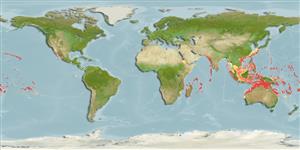>
Holocentriformes (Squirrelfishes, soldierfishes) >
Holocentridae (Squirrelfishes, soldierfishes) > Holocentrinae
Etymology: Sargocentron: Greek, sargos = sargus + Greek, kentron = sting (Ref. 45335).
More on author: Cuvier.
Environment: milieu / climate zone / depth range / distribution range
Écologie
marin récifal; profondeur 0 - 183 m (Ref. 9710), usually 1 - 20 m. Tropical; 32°N - 28°S
Indo-Pacific: East Africa to the Hawaiian, Marquesan, and Ducie islands, north to southern Japan, south to Australia and the Austral Islands; throughout Micronesia.
Taille / Poids / Âge
Maturity: Lm ? range ? - ? cm
Max length : 33.0 cm TL mâle / non sexé; (Ref. 4201)
Épines dorsales (Total): 11; Rayons mous dorsaux (Total): 13-15; Épines anales 4; Rayons mous anaux: 9. Body is red with silvery red stripes overlaid with blue iridescence; spinous portion of dorsal fin red with white-tipped spines and a white blotch in the middle of each membrane; leading edges of pelvic and anal spines white (Ref. 2334). Five oblique scale rows on cheek; body depth 2.6-2.95 in SL; head length (HL) 2.6-2.9 in SL; snout often shorter than orbit diameter, its length 3.6-3.9 in HL; interorbital width 5.05-5.85 in HL; maxilla extending posteriorly from center of eye to below rear edge of the pupil, upper jaw length 2.2-2.3 in HL; premaxillary groove usually reaching to a vertical at front edge of the orbit; anterior end of nasal bone with 2 short diverging spines; medial margin of nasal bone spineless; large nasal fossa without spinules on margin; slight ridge along the upper edge of suborbital bones with low recumbent spinules in young, becoming smooth in adults, at least below the anterior half of orbit; opercle with 2 large subequal opercular spines; preopercular spine, 3.6-5.2 in HL; short dorsal spines, 3rd to 5th subequal, 4th dorsal spine usually longest, 2.6-3.5 in HL; 3rd anal spine 1.5-2.3 in HL (Ref. 27370).
Occurs along exposed reef margins and outer reef slopes. Has been observed at depth of 183 m in Hawaii (Ref. 1602). Benthopelagic (Ref. 58302). Secretive during the day and hides in holes and crevices of surge channels. Feeds at night on crustaceans, crustacean larvae, polychaete worms, and small fishes. Spine of preopercle venomous. Minimum depth reported taken from Ref. 128797.
Life cycle and mating behavior
Maturité | Reproduction | Frai | Œufs | Fécondité | Larves
Randall, J.E., 1998. Revision of the Indo-Pacific squirrelfishes (Beryciformes: Holocentridae: Holocentrinae) of the genus Sargocentron, with descriptions of four new species. Indo-Pac. Fish. (27):105 p. (Ref. 27370)
Statut dans la liste rouge de l'IUCN (Ref. 130435)
Utilisations par l'homme
Plus d'informations
Noms communsSynonymesMétabolismePrédateursÉcotoxicologieReproductionMaturitéFraiRassemblement de ponteFéconditéŒufsDéveloppement de l'œuf
RéférencesAquacultureProfil d'aquacultureSouchesGénétiqueElectrophoresesHéritabilitéPathologiesTraitementNutrientsMass conversion
Outils
Articles particuliers
Télécharger en XML
Sources Internet
Estimates based on models
Preferred temperature (Ref.
123201): 24.9 - 28.9, mean 27.6 °C (based on 702 cells).
Phylogenetic diversity index (Ref.
82804): PD
50 = 0.5000 [Uniqueness, from 0.5 = low to 2.0 = high].
Bayesian length-weight: a=0.02239 (0.01400 - 0.03580), b=2.98 (2.84 - 3.12), in cm total length, based on LWR estimates for this species & Genus-body shape (Ref.
93245).
Niveau trophique (Ref.
69278): 4.2 ±0.71 se; based on food items.
Résilience (Ref.
120179): Haut, temps minimum de doublement de population inférieur à 15 mois (Preliminary K or Fecundity.).
Fishing Vulnerability (Ref.
59153): Low vulnerability (23 of 100).
Nutrients (Ref.
124155): Calcium = 40.5 [16.0, 168.0] mg/100g; Iron = 0.493 [0.206, 1.490] mg/100g; Protein = 18.6 [17.5, 19.8] %; Omega3 = 0.171 [0.075, 0.381] g/100g; Selenium = 41.5 [23.9, 79.9] μg/100g; VitaminA = 115 [45, 298] μg/100g; Zinc = 1.3 [0.5, 2.4] mg/100g (wet weight);
